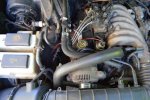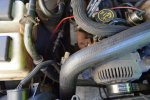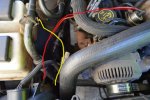DoctorRoboto
New Member
- Joined
- May 16, 2016
- Messages
- 34
- Reaction score
- 0
- Points
- 0
- Location
- Portland, OR
- Vehicle Year
- 1998
- Make / Model
- Ford
- Engine Size
- 4.0L
- Transmission
- Automatic
- My credo
- When life gives you lemons, just shut up and eat your lemons.
I have a '95 B3000 and have been having trouble with the cabin HVAC vacuum. I have a parallel thread over here about that, been trying to chase down why doors aren't opening and such. But I believe I have a much more major vacuum line hookup problem, courtesy of the PO.
I have been trying to figure out the vacuum situation in the vacuum reservoir, to see where the problem is in supplying vacuum to the cabin for control of those doors. I traced the vacuum supply line for the reservoir to the fuel pressure regulator. Attached is a couple of pictures of the vacuum line routing for those bits. If you look at the red vacuum line, it goes directly from the top of the FPR right into that black spherical reservoir (which does hold vacuum BTW, I tested it with a vacuum gauge I just got). The other end of the reservoir disappears under the blower motor, but I think it's the input to the cabin vacuum controls. So the FPR doesn't seem to be hooked up to the manifold, and similarly, the reservoir is not hooked up to the manifold either.
Is this right? Is the FPR supposed to go straight to the reservoir? From what I've been reading, it seems like both of these thing need to go to the intake manifold, not to each other.
A slightly annotated visual is also included. The red line goes from the FPR to the black spherical reservoir. The yellow line is actually a black hose, and goes (I think) up to the firewall. It's certainly not pulling a major vacuum from the intake.
I have been trying to figure out the vacuum situation in the vacuum reservoir, to see where the problem is in supplying vacuum to the cabin for control of those doors. I traced the vacuum supply line for the reservoir to the fuel pressure regulator. Attached is a couple of pictures of the vacuum line routing for those bits. If you look at the red vacuum line, it goes directly from the top of the FPR right into that black spherical reservoir (which does hold vacuum BTW, I tested it with a vacuum gauge I just got). The other end of the reservoir disappears under the blower motor, but I think it's the input to the cabin vacuum controls. So the FPR doesn't seem to be hooked up to the manifold, and similarly, the reservoir is not hooked up to the manifold either.
Is this right? Is the FPR supposed to go straight to the reservoir? From what I've been reading, it seems like both of these thing need to go to the intake manifold, not to each other.
A slightly annotated visual is also included. The red line goes from the FPR to the black spherical reservoir. The yellow line is actually a black hose, and goes (I think) up to the firewall. It's certainly not pulling a major vacuum from the intake.
Attachments
-
88.6 KB Views: 688
-
77.9 KB Views: 891
-
81.1 KB Views: 1,975
Last edited:





















